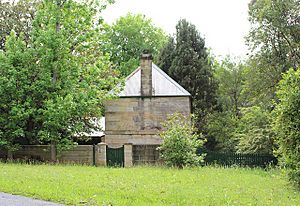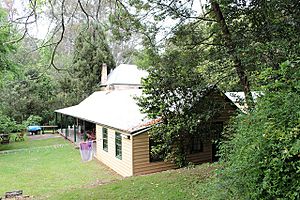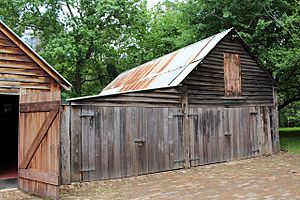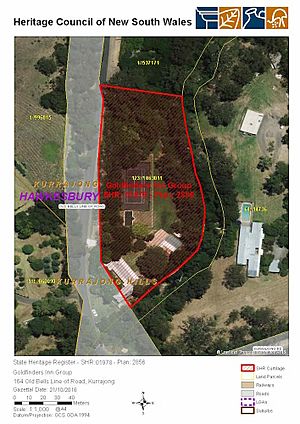Goldfinders Inn facts for kids
Quick facts for kids Goldfinders Inn |
|
|---|---|

View of Goldfinders Inn, from the road
|
|
| Location | 164 Old Bells Line of Road, Kurrajong, City of Hawkesbury, New South Wales, Australia |
| Built | 1809–1830 |
| Official name: Goldfinders Inn Group; Gold Finders Rest; Kurrajong General Store; Kurrajong Post Office | |
| Type | state heritage (built) |
| Designated | 21 October 2016 |
| Reference no. | 1978 |
| Type | Other - Residential Buildings (private) |
| Category | Residential buildings (private) |
| Builders | John Lamrock |
| Lua error in Module:Location_map at line 420: attempt to index field 'wikibase' (a nil value). | |
Goldfinders Inn is a very old building in Kurrajong, New South Wales, Australia. It used to be an inn (like a hotel), a guesthouse, a general store, and even a post office! Today, it's a private home. This special place was built between 1809 and 1830 by John Lamrock. It's also known by other names like Gold Finders Rest and Kurrajong General Store. Because of its long history, it was added to the New South Wales State Heritage Register on October 21, 2016.
Contents
A Journey Through Time: Goldfinders Inn History
Who Lived Here First?
The story of Goldfinders Inn begins with Rowland Edwards. He arrived in Sydney in 1791. He was a convict, meaning he was sent to Australia as punishment. After seven years, he became a free person. By 1798, he was living near the Hawkesbury River.
In 1806, records show Edwards was a free settler. He had bought 80 acres of land at Richmond Hill. He lived there with his wife and child. They were able to support themselves, which means they likely had a home on the land by then. In 1809, Governor William Paterson officially gave Edwards the land.
Richmond Hill was a general name for the area. But "High Lands" referred specifically to where Kurrajong is today. This means Edwards was living at the Goldfinders Inn site by 1809. He might have built the oldest part of the cottage around this time.
The Road to the Inn
In 1823, a new road was surveyed by Archibald Bell Jr. This road, now called Old Bells Line of Road, followed an old Aboriginal path. It was built by 1825 and officially opened in 1841.
The first cottage at Goldfinders Inn was made from local timber. It was built in a simple, traditional style. This was because there wasn't a good road to bring in other materials. It's likely the oldest part of the cottage was built before 1840.
From Farm to Famous Inn
The Edwards family lived on the property until about 1842. Then, it was sold to John Rule. Around 1850, John Rule sold it to John Lamrock. Lamrock built a new, two-storey building made of sandstone. He opened it as an inn called "Goldfinders Home."
This inn was important for gold diggers. They would stop there while traveling to and from the goldfields in the west. The inn quickly became the heart of the local community. It also served as a general store and a post office. Many public meetings were held there.
Even after the inn stopped being licensed in 1871, it continued to be a post office, general store, and guesthouse. People would write in newspapers about their stays there. The guesthouse used both buildings and had some additions, which are now gone.
New Owners and Continued Use
Later, Henry and Robert Pitt owned the property. Their family had lived in the Hawkesbury area for many years. In 1922, James Pye bought it. He was a local blacksmith. During his time, until 1944, the property remained a general store and post office. It was still a place for community gatherings. The Post Office moved before the property was sold in 1944.
Since 1944, Goldfinders Inn has had several owners. One notable owner was Paddy McGuinness, a journalist. In 1975, Chris and Deborah Hallam bought the property. Deborah Hallam is actually a direct descendant of Henry Pitt, one of the earlier owners!
Over the years, work has been done to preserve the buildings. In 1979, Philip Cox and Partners designed conservation work for the inn. In 1987, the cottage was also worked on. A new section connecting the two main buildings was added in 2010.
What Does Goldfinders Inn Look Like?
The Goldfinders Inn property has three main buildings. They are located at the southern end of the site. These buildings include a single-storey timber cottage, a two-storey sandstone inn, and a timber barn. They are surrounded by a garden with old, tall trees.
The Old Cottage
The oldest part of the cottage might be from as early as 1809. Its walls are made of timber slabs and broad-axed (roughly cut) timber frames. Spaces between the timber studs were filled with sandstone rubble. This is called "stone nogging" and is a very rare building method. It shows how people used local materials when it was hard to transport things. The roof was originally timber shingles, but now has corrugated metal over them.
The Sandstone Inn
The two-storey inn building is made of smooth, cut sandstone blocks called ashlar. Its original timber shingle roof has been replaced with corrugated metal. Some parts that were added later, like a shop front, have been removed. But you can still see the original layout inside.
The Barn and Garden
There's also a barn made of vertical timber slabs. It has been extended using new and recycled slabs. The garden between the inn and cottage is home to a large, old magnolia tree and two big camellia bushes. One of the camellias was even identified as the oldest in Australia by an expert named Professor Eben Gowrie Waterhouse! Photos suggest these plants might be from the 1850s.
How Well Preserved Are the Buildings?
As of 2013, all three buildings were in good condition. Work done in 1979 and 1987 helped protect them from the weather. Even though some parts have been repaired or changed, the buildings still look very much like they did in the past. You can still see their original shapes and how they were built.
Why is Goldfinders Inn Important?
Goldfinders Inn is very important to the history of New South Wales. It has been lived in continuously since 1809! The cottage, inn, and barn show how the site changed over time. It went from a farm to a busy inn, then a post office and general store, and now a home.
The inn's location was perfect for travelers on Bells Line of Road. It offered a place to rest and get supplies during long journeys through the mountains. Before Kurrajong had a formal town center, Goldfinders Inn was the main hub for the community.
The cottage is a rare example of an early building from the Hawkesbury area. Its unique construction, like the stone nogging (stone filling between timber studs), shows how people built homes in remote areas using local materials.
The garden is also special. The very old magnolia and camellia plants are rare. One camellia is even thought to be the oldest in Australia!
Studying Goldfinders Inn can teach us more about how early buildings were constructed. It might also reveal more about the different ways the place was used over its long history.
Goldfinders Inn was added to the New South Wales State Heritage Register on October 21, 2016, because it meets several important criteria:
- It shows the history of New South Wales, from early settlement to a busy community center.
- It can help us learn more about early building methods, especially the rare stone nogging.
- It has rare features, like the old cottage construction and the very old garden plants.
- It represents how important places developed in small towns across New South Wales.





